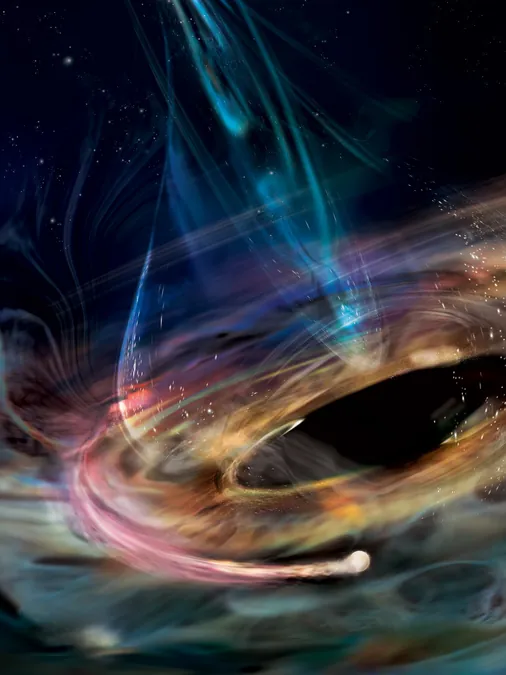
New Discoveries Reshape Our Understanding of Giant Black Holes!
2025-01-16
Author: Yu
Recent astronomical observations are stirring up a storm in the world of astrophysics, challenging long-held beliefs about the enigmatic giants known as black holes. These colossal entities form when massive stars end their life cycles, succumbing to gravitational collapse after exploding in a spectacular supernova. The fundamental principles defining black holes were laid out by pioneering scientists such as Karl Schwarzschild and Subrahmanyan Chandrasekhar, driven by Einstein’s revolutionary Theory of General Relativity. Though scientists confirmed in the 1970s that supermassive black holes (SMBHs) lurk at the hearts of massive galaxies and significantly influence their evolution, many aspects of their behavior remain shrouded in mystery.
Recently, groundbreaking research led by a team from MIT has unveiled astonishing new details about SMBHs. Observations of a black hole in a neighboring galaxy revealed oscillations indicating that the SMBH was consuming a white dwarf star—fascinatingly, instead of being torn apart, the white dwarf's descent slowed down, defying all expectations of current astronomical models.
Megan Masterson, a dedicated PhD student at the MIT Kavli Institute for Astrophysics and Space Research, spearheaded this remarkable study, bringing together researchers from various prestigious institutions including NASA and the Harvard-Smithsonian Center for Astrophysics. Their findings contribute to a growing body of evidence that suggests black holes are far more complex than previously believed.
Traditionally, astronomers have understood that the regions surrounding black holes, filled with matter (gas, dust, and light), create brilliant disks that whirl around as they spiral into the black hole. As this matter approaches, intense heat and radiation—primarily ultraviolet—are emitted, which then interacts with a hot plasma corona around the black hole, resulting in X-ray emissions.
The galaxy of interest, 1ES 1927+654, sits approximately 236 million light-years away in the constellation Draco. It houses a black hole boasting a mass 1.4 million times that of our Sun. Observations from NASA's XMM-Newton satellite have been monitoring this galaxy since 2011, revealing intriguing phenomena since the black hole's corona mysteriously vanished in 2018, which sparked an unusual radio outburst and a rise in X-ray emissions.
Eileen Meyer, an associate professor at UMBC and collaborator on the study, highlighted how the black hole underwent significant changes, causing excitement across the astronomical community. As scientists continue to observe its eruptions and behavior, they are piecing together the puzzle of how such cosmic giants operate.
One standout moment in this saga occurred between February and May 2024, when data suggested jets of ionized gas were erupting from the SMBH—an event that had never been witnessed in real-time before! Meyer pointed out that these jets likely encapsulated pivotal moments of a fundamental phenomenon in black hole evolution.
Moreover, during April 2023, a sudden uplift in low-energy X-rays hinted at a staggeringly robust radio flare. The team's findings revealed rapid variations in these X-ray emissions, typically challenging to detect, indicating the presence of a substantial object orbiting close to the SMBH, slowly meeting its end.
An unexpected twist came when the orbital period oscillated, leading to initial confusion among the research team. Masterson explained, “The strong gravitational force might be stripping mass away from the companion white dwarf, counteracting energy loss and slowing down its inward spiral.”
This remarkable discovery led to the suggestion that the current scenario resembles other systems where white dwarfs gradually merge. The implications here could be groundbreaking. Their observations, reliant on the powerful capabilities of future observational technology, such as the upcoming Laser Interferometer Space Antenna (LISA), might soon validate the theory that a white dwarf is indeed orbiting the supermassive black hole.
"This could revolutionize our understanding of black hole dynamics," Masterson concluded, emphasizing the crucial role that forthcoming research could play in tearing down old paradigms. Black holes, it appears, have more secrets to reveal, and scientists are on the brink of uncovering them. Stay tuned as we explore where these incredible discoveries may lead us next!


 Brasil (PT)
Brasil (PT)
 Canada (EN)
Canada (EN)
 Chile (ES)
Chile (ES)
 Česko (CS)
Česko (CS)
 대한민국 (KO)
대한민국 (KO)
 España (ES)
España (ES)
 France (FR)
France (FR)
 Hong Kong (EN)
Hong Kong (EN)
 Italia (IT)
Italia (IT)
 日本 (JA)
日本 (JA)
 Magyarország (HU)
Magyarország (HU)
 Norge (NO)
Norge (NO)
 Polska (PL)
Polska (PL)
 Schweiz (DE)
Schweiz (DE)
 Singapore (EN)
Singapore (EN)
 Sverige (SV)
Sverige (SV)
 Suomi (FI)
Suomi (FI)
 Türkiye (TR)
Türkiye (TR)
 الإمارات العربية المتحدة (AR)
الإمارات العربية المتحدة (AR)